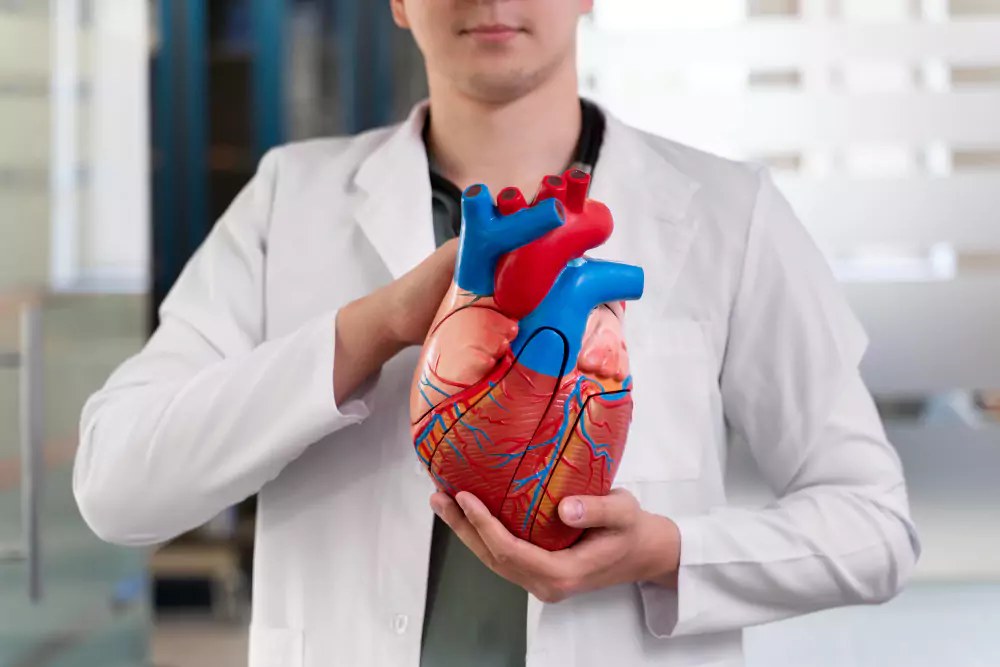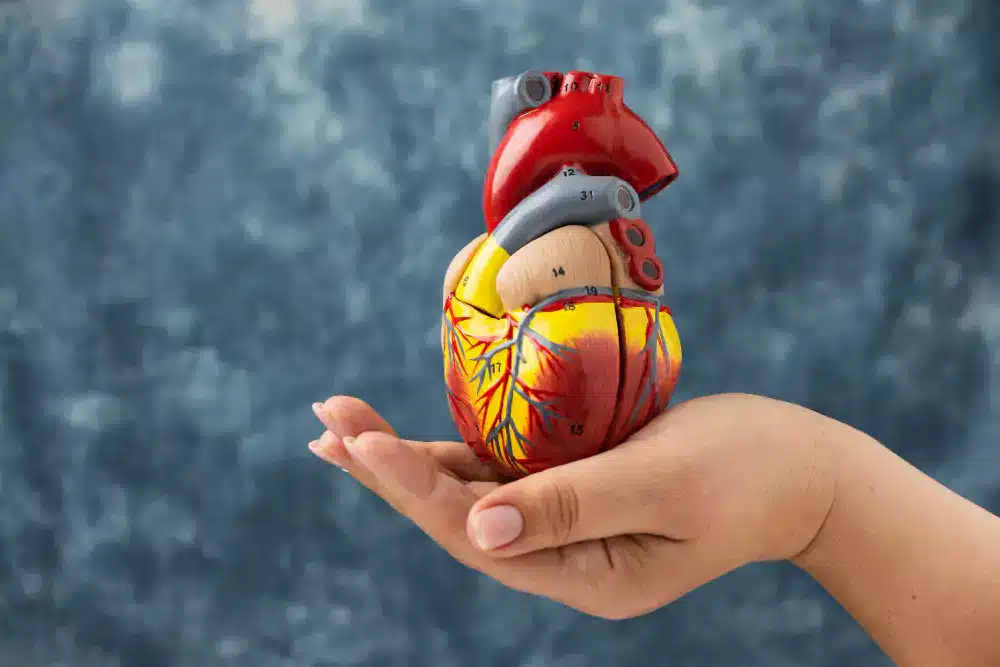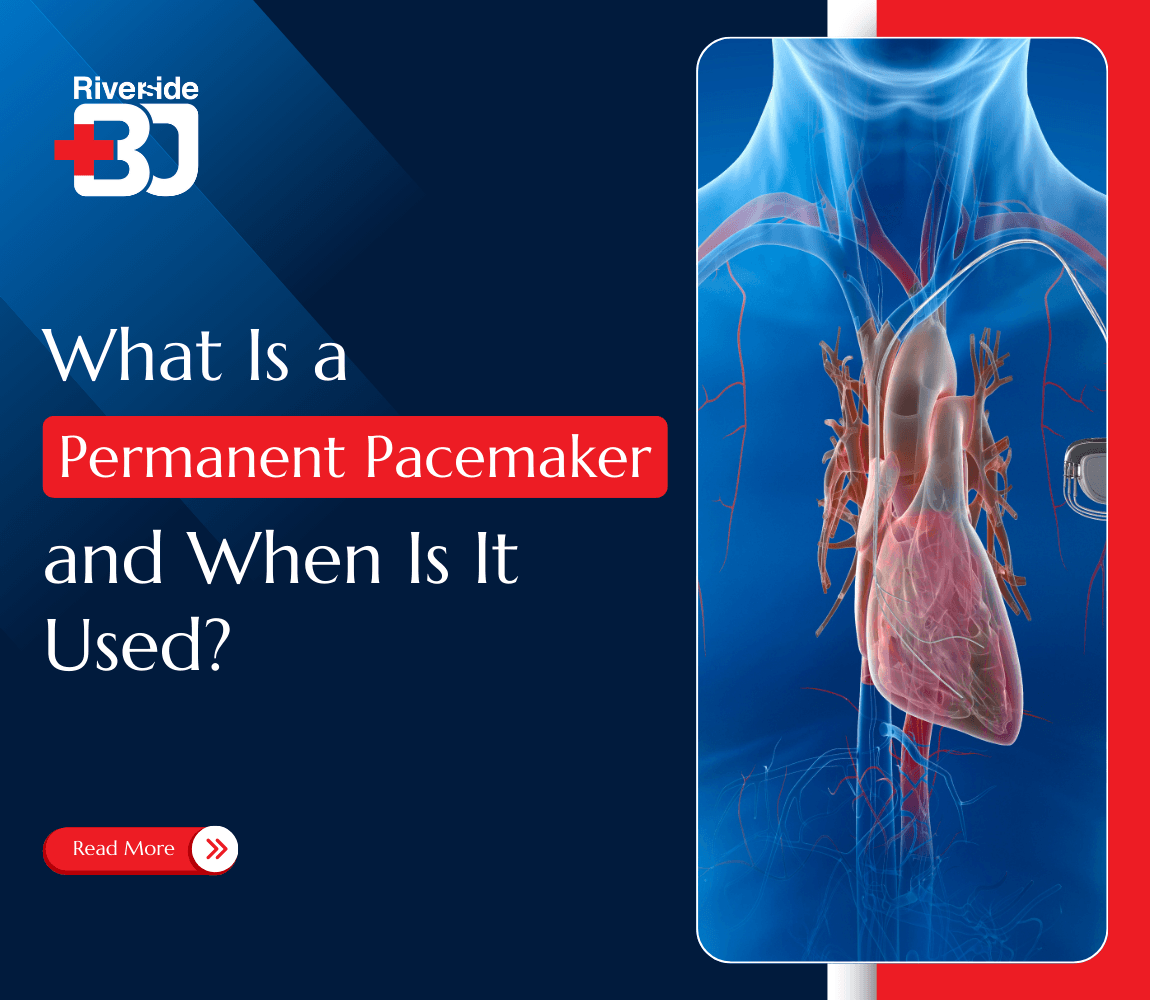Doctors implant a permanent pacemaker under the skin to regulate abnormal heart rhythms. It assures the heart beats steadily and effectively, reducing complications like fainting or heart failure.
Consider these statistics:
- According to PubMed, in England, approximately 34,000 permanent pacemakers are implanted annually. The implantation rates are rising by about 4.7% per decade.
- Additionally, as per Research Gate, in India, more than 20,000 pacemakers are implanted each year. The numbers are growing annually.
These figures highlight the increasing reliance on pacemakers to manage heart rhythm disorders.
This blog examines the conditions that make a permanent pacemaker necessary. It details the implantation process, outlines potential risks, and shares key recovery guidelines for patients.
So, let’s first understand when patients require a permanent pacemaker.

When is a Permanent Pacemaker Needed?
When the heart fails to maintain a steady rhythm, it causes fatigue, dizziness, or fainting, requiring a permanent pacemaker. It is essential for conditions that disrupt normal electrical signalling. Without intervention, these disorders can lead to severe complications, affecting overall heart function.
1. Sinus Node Dysfunction (SND)
The sinus node controls the heart’s rhythm, but dysfunction can cause irregular, slow, or paused beats. Patients may experience dizziness, extreme fatigue, or blackouts.
A permanent pacemaker helps restore proper electrical impulses, allowing the heart to function efficiently. Additionally, early intervention can significantly improve symptoms and prevent further complications.
2. Atrioventricular (AV) Block
Electrical signals must travel smoothly between the heart chambers. AV block disrupts this flow, leading to delays or missed beats. Depending on severity, symptoms range from mild fatigue to sudden loss of consciousness.
Thus, a permanent pacemaker regulates impulses, ensuring timely contractions. This intervention helps restore a normal heartbeat and prevents life-threatening complications.
3. Other Indications
Several medical conditions affect the heart’s electrical activity, leading to life-threatening rhythm disturbances. When these issues persist despite other treatments, doctors recommend a permanent pacemaker to restore normal function and improve quality of life.
- Symptomatic Bradycardia (Slow Heart Rate)-
When the heart beats too slowly, it can cause weakness and lightheadedness. Therefore, in such cases, a pacemaker helps maintain a stable rhythm.
- Certain Types Of Heart Failure-
Some heart failure patients require pacemakers to synchronise contractions and improve overall function. This treatment enhances circulation and reduces symptoms.
- Specific Neuromuscular Diseases-
Disorders affecting nerve signals can weaken heart contractions. A pacemaker compensates by providing electrical impulses and maintaining normal function.
Recognising these conditions early can lead to timely treatment and better health outcomes. Ultimately, a permanent pacemaker plays a crucial role in restoring normal heart function and improving quality of life.
Understanding these conditions highlights the crucial role of a permanent pacemaker in maintaining heart function. Now, let’s explore the different types of permanent pacemakers and how they cater to specific cardiac needs.
Types of Permanent Pacemakers
A permanent pacemaker helps regulate heart rhythm by delivering electrical impulses. However, different types cater to specific cardiac needs. Each device varies in function, addressing unique conditions that disrupt normal heart activity.
Selecting the right pacemaker depends on the severity of the electrical abnormalities.
- Single-Chamber Pacemaker
This permanent pacemaker sends electrical impulses to a single heart chamber, either the right atrium or ventricle. Subsequently, it corrects irregular heartbeats and helps maintain a stable rhythm.
Patients with sinus node dysfunction or chronic atrial fibrillation commonly receive this device. Although it lacks coordination between chambers, it significantly improves symptoms. Its implementation remains a simple and effective solution.
- Dual-Chamber Pacemaker
Unlike a single-chamber pacemaker, this device regulates electrical activity between two chambers. Consequently, it improves communication between the atrium and ventricle, preventing delays or missed beats.
This pacemaker mimics natural heart rhythm, helping those with atrioventricular block. Maintaining synchronised contractions enhances blood circulation.
With this pacemaker, patients experience fewer symptoms and enjoy better overall heart function after implantation.
- Biventricular Pacemaker (CRT)
This permanent pacemaker corrects uncoordinated contractions in heart failure patients. Furthermore, it stimulates both ventricles and improves blood circulation. Hence, reducing strain on the heart. This intervention significantly enhances cardiac efficiency.
With this pacemaker, many individuals regain strength and experience fewer complications. Therefore, it is an essential treatment for those with severe heart failure symptoms. Additionally, restoring balance in contractions leads to a healthier, more active life.
Choosing the appropriate pacemaker requires understanding each type’s function and benefits. Every device plays a critical role in restoring normal heart activity.
Next, let’s examine how doctors implant a permanent pacemaker and what patients can expect during the procedure.

The Implantation Procedure
A permanent pacemaker implantation is a straightforward yet delicate procedure. In this procedure, doctors carefully position the device to regulate heart rhythm effectively. Every step, from preparation to placement, requires precision.
Understanding the process helps patients feel confident about the surgery and its outcome.
1. Preparation
Doctors first conduct essential evaluations, including ECGs and imaging scans. These tests determine the optimal pacemaker placement.
After the assessments, local anaesthesia numbs the surgical area. During this, patients remain awake and experience no pain. Subsequently, the medical team monitors vital signs continuously. Every precaution ensures a safe and controlled procedure, minimising risks and improving success rates.
- Pre-Procedure Evaluations And Tests-
A thorough medical evaluation helps doctors assess heart health before implantation of the permanent pacemaker. Therefore, they analyse heart rhythm patterns and look for irregularities.
Tests such as stress echo provide insight into cardiac function. Furthermore, these evaluations help determine the best type of permanent pacemaker. A detailed assessment ensures the procedure aligns with the patient’s specific heart condition.
- Administration Of Local Anesthesia –
Doctors administer a local anesthetic to numb the incision site. This prevents pain while allowing patients to remain awake. Additionally, the numbing effect ensures comfort throughout.
Anaesthesia dosage is carefully controlled. Subsequently, the team monitors patient response to provide stability. This step prepares the patient for the next phase of the procedure.
2. Procedure Steps
A permanent pacemaker implantation follows a series of precise steps, each playing a crucial role in achieving a successful outcome. Doctors follow a structured approach to ensure the device functions optimally and enhances the patient’s quality of life.
- Making An Incision Below The Collarbone –
Firstly, surgeons create a small incision just below the collarbone. This location allows easy access to veins leading to the heart.
The incision is carefully made to prevent excessive bleeding. Doctors work meticulously to keep the wound minimal. Proper placement of the incision ensures a seamless procedure and comfortable recovery.
- Inserting Leads Into The Heart Via A Vein –
Once the incision is made, thin, flexible leads are inserted into a nearby vein. From there, these leads travel toward the heart under imaging guidance.
To assure accuracy, doctors verify proper positioning so the permanent pacemaker delivers precise electrical impulses. Any misalignment is corrected immediately. Before continuing, doctors carefully test the connection.
- Connecting Leads To The Pacemaker Device-
After the leads are in place, doctors attach them to the permanent pacemaker. Since this device stabilises heartbeats, it is crucial to confirm its proper function.
At this stage, the connection undergoes rigorous testing. If any inconsistencies arise, doctors should make immediate adjustments. This way, potential malfunctions or future complications are prevented.
- Positioning The Device Under The Skin-
After connecting the leads, doctors place the permanent pacemaker beneath the skin near the incision site. They position it carefully to prevent unnecessary pressure and maximise comfort.
Once positioned correctly, they program the device for optimal function. Finally, they close the incision using sutures or adhesive strips, ensuring long-term reliability and comfort.
3. Duration
Typically, the procedure takes one to three hours. However, the exact time depends on individual factors.
Most patients recover quickly and are discharged on the same day. Meanwhile, some may experience mild discomfort initially, but it fades quickly.
Additionally, doctors also provide post-procedure care guidelines to promote a smooth healing process.
While the implantation procedure is generally safe, it is essential to understand the potential risks and complications. Let’s explore the possible challenges patients may face after receiving a permanent pacemaker.
Risks and Complications
A permanent pacemaker helps regulate heartbeats, but some risks exist. Infection, lead displacement, or excessive bruising may occur. Rare complications, like a collapsed lung, require immediate medical intervention to prevent further health issues.
- Infection At The Implantation Site:
Bacteria may enter the incision, causing redness, swelling, or pus formation. Moreover, some individuals develop fever or chills, signaling an infection that requires antibiotics. In severe cases, pacemaker removal becomes necessary.
Doctors minimize infection risks by maintaining sterility. Subsequently, patients keep the incision dry, avoid unnecessary contact, and report any discomfort. Doctors conduct regular check-ups to monitor healing and prevent complications.
- Lead Displacement
Leads send electrical impulses, but sometimes, they shift unexpectedly. As a result, displacement causes dizziness, heart rhythm disturbances, or ineffective pacing. To correct this, medical intervention restores normal permanent pacemaker function.
Surgeons secure leads carefully, reducing movement risks. Meanwhile, patients must avoid heavy lifting, sudden arm motions, or unnecessary strain. If irregular heartbeats or persistent discomfort arise, consulting a doctor immediately becomes essential.
- Bleeding Or Bruising
Bruising around the incision appears normal, yet excessive bleeding indicates complications. In particular, some individuals, especially those on blood thinners, experience prolonged swelling or discolouration. Hence necessitating medical evaluation.
Doctors monitor for abnormal signs post-surgery. In addition, patients should avoid pressure on the chest, monitor changes, and inform specialists of concerns. Prompt attention prevents issues, ensuring smooth recovery without complications.
- Rare Complications Such As a Collapsed Lung
In rare cases, the permanent pacemaker leads to puncture of the lung lining. Therefore, causing air leakage. This results in breathlessness, chest pain, or severe fatigue. Moreover, immediate medical intervention prevents worsening conditions.
Doctors use imaging techniques to detect lung complications early. Treatment includes oxygen therapy or drainage procedures. Additionally, patients should report persistent coughing, sharp discomfort, or unexpected breathing difficulties to their cardiologist immediately.
Although complications sound concerning, proper precautions significantly reduce risks.
Now, let’s explore the recovery process and lifestyle adjustments needed after a permanent pacemaker implantation.
Recovery and Lifestyle Considerations
Recovering from pacemaker implantation requires careful monitoring and lifestyle adjustments. Patients must protect the incision site, follow medical advice, and attend regular check-ups. Gradually, normal activities resume with certain necessary precautions.
1. Post-Procedure Care
Adapting to life with a permanent pacemaker requires careful monitoring, lifestyle adjustments, and regular medical check-ups. Patients must stay cautious, follow medical advice, and make necessary changes to protect long-term pacemaker functionality.
- Monitoring The Incision Site-
Inspecting the site daily prevents complications. Noticing redness or swelling early aids in timely intervention. Although mild discomfort is expected.
Excessive pain requires immediate consultation. Therefore, bandages should be changed hygienically. Additionally, water exposure must be controlled. Gentle cleansing helps. Scratching or disturbing stitches delays healing, risking infections.
- Activity Restrictions During Initial Recovery-
Moving cautiously prevents lead displacement. Reaching overhead must be limited. The gradual resumption of activities should be avoided to avoid further complications.
Engaging in moderate movement enhances circulation. However, overexertion strains healing tissues. Walking helps in assisting the recovery process; however, running should wait. Frequent rest ensures effective adjustment, supporting overall pacemaker functionality effectively.
2. Living with a Pacemaker
A permanent pacemaker demands vigilance and care. The following cautions can help avoid device malfunctions. Being mindful of environmental factors is crucial.
- Regular Follow-Up Appointments –
Routine medical visits should be made to track the pacemaker’s performance. Adjustments may be necessary. Monitoring heart function prevents potential failures. Timely assessments should be made for continued effectiveness.
Unusual symptoms with doctors should be discussed. Skipping appointments could risk complications. Updated records help during emergencies. Professional evaluations guide long-term cardiac health.
- Avoiding Strong Electromagnetic Interference –
Certain devices may disrupt the functioning of the permanent pacemaker. Mobile phones should be kept away from the chest. Additionally, strong magnets should be kept away as they pose risks.
Microwave ovens are generally safe. However, one needs to be cautious around high-voltage equipment. Medical procedures involving electromagnetic fields need prior consultation. Awareness helps maintain uninterrupted permanent pacemaker operation without unnecessary concerns.
- Resuming Normal Activities With Certain Precautions –
Patients must have patience when returning to daily routines. They should perform light exercises to improve their cardiovascular health but must avoid excessive strain.
They should temporarily postpone driving. Additionally, they must modify gym activities since sudden movements pose risks. They can attend social engagements but should minimise stressful environments. Ultimately, maintaining balanced routines promotes a healthier lifestyle.
A permanent pacemaker enhances the functioning of the heart, yet careful management is essential. Regular check-ups, lifestyle adjustments, and adherence to medical advice ensure longevity. Ultimately, prioritizing the heart’s health leads to a stable, active, and fulfilling life.

Conclusion
A permanent pacemaker significantly improves the heart’s rhythm, yet patients must carefully follow medical recommendations. Adaptation takes time, but this device allows individuals to maintain active lifestyles without constant concern. Furthermore, it restores confidence by ensuring a steady heart function.
In addition to this, lifestyle adjustments help extend a pacemaker’s longevity. Simple precautions, such as avoiding strong electromagnetic fields, greatly enhance safety and performance.
Ultimately, long-term health of the heart depends on consistent care and mindful habits. While each patient’s experience varies, the above medical guidelines guarantee stability, reliability, and improved heart function for years to come.
At Riverside B&J Hospital, expert cardiologists provide advanced permanent pacemaker treatment. Book an appointment today for world-class heart care.
FAQs
1. How Does a Permanent Pacemaker Help in Heart Conditions?
A permanent pacemaker regulates heartbeats, preventing dangerously slow rhythms. Consequently, it reduces symptoms like dizziness or fatigue. As a result, patients experience improved heart function and better overall well-being.
2. When Should Someone Consider Getting a Permanent Pacemaker?
Doctors recommend a permanent pacemaker if severe bradycardia, heart block, or irregular heartbeats cause symptoms. Furthermore, individuals with specific heart failure conditions may benefit significantly from its implantation.
3. Is The Permanent Pacemaker Implantation Procedure Painful?
Typically, local anaesthesia minimises discomfort. While minor soreness might persist initially, patients rarely experience severe pain. Additionally, medications help manage post-procedure discomfort effectively.
4. Can Someone Live a Normal Life With a Permanent Pacemaker?
Absolutely! After recovery, individuals can resume their daily routines, including exercise. However, avoiding strong electromagnetic fields is necessary. Moreover, regular follow-ups ensure the device functions optimally.
5. What Are The Risks of a Permanent Pacemaker?
Although complications are rare, potential risks include infection or lead displacement. Nonetheless, proper post-procedure care reduces these risks. Hence, following medical advice ensures a smooth recovery and pacemaker longevity.

